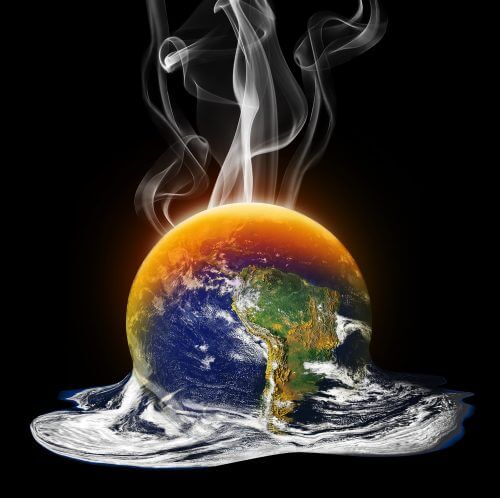The past three years have been the warmest ever recorded, and current forecasts indicate a high probability of at least four more warm years in a row
By Ran Ben Michael, Angle - Science and Environment News Agency

It is still hot in Israel, although "normal for the season", and in many places in the world where a heat wave hit with an unknown intensity, the temperatures subsided somewhat. However, this is probably not the end of the story. The unusual heat wave naturally raises the question "what will happen?", the answer to which is usually given with a limited guarantee. Weather forecasting is not accurate for long periods, and long-term climate models do not provide unequivocal answers about the foreseeable future. The chaotic nature of the natural climate system makes it difficult to make such predictions, and the models become even more complex when the uneven conditions created by global climate change are taken into account.
The past three years 2015-2017 were the warmest on record, and measurements up to mid-2018 indicate that this one will probably join them in fourth place. The four years are on a streak of 40 years in which the temperature exceeded the 20th century average. Now, according to a new model, it seems that the next four years (2019-2022) will only continue these trends, and probably surpass their previous ones.
A combination of natural and human warming
In an article recently published in the scientific journal Nature Communications, a team led by Florian Savelek, from the Department of Earth Sciences at the University of Southampton in England and the Ocean Research Laboratory at the University of Brest in France, proposes a new model of probabilistic forecasting. This model is different from others that try to simulate a future situation (simulation) according to the game of variables in relation to the current situation. According to the new approach, the model calculates the probability of transition to a future state in the climate system according to the algorithm that studies similar occurrences in the past. The algorithm studies the possible moves of the natural climate system and then includes the effects of climate change due to greenhouse gas emissions.
"The climate system has natural internal variability and there are complex interrelationships between the atmosphere, the oceans, the polar ice caps and the biosphere, and between them there are mutual effects in various feedback mechanisms. Natural variation also includes short-term cyclical fluctuations of several years, such as the North Atlantic Oscillation and the El Nino Southern Oscillation," says Prof. Yoav Yair, dean of the School of Sustainability at the Interdisciplinary Center in Herzliya and an expert in atmospheric and space sciences. "These are movements of large atmospheric pressure systems associated with relatively slow changes in sea surface temperatures, the movement of ocean currents and the redistribution of heat in the oceans and atmosphere. There are also random effects such as large volcanic eruptions, which can inject huge amounts of volcanic ash into the stratosphere - ash that reflects solar radiation into space, which causes short-term cooling, and can even affect the global climate system. In 1816, for example, there was a 'year without summer' following a volcanic eruption a year earlier, which resulted in a rainy and cool summer in Europe and North America."
"A precise monitoring of the intensity of the short-cycle changes shows that due to the overall climatic warming, the amplitude of these fluctuations is also increasing, and indeed the intensity of the last El Niño event, which ended in 2016, was the strongest in this century. In other words, the ongoing climate change due to man-made emissions of greenhouse gases into the atmosphere means that the warmer the system itself, the more extreme events and the intensity of short-term changes can be expected.
According to the findings of the new model - whose degree of accuracy is similar to short-term (operational) forecasts and which offers a relatively high degree of certainty - an increase in the average air temperature over land and in the sea surface temperature is expected during the next four years at least (and even more so in the sea surface temperature). In other words, it is quite likely that during these years it will be warmer than expected due to a combination of natural warming along with climate change caused by human activity.

The model is economical, the results are disastrous
In the years 1998–2013, the rate of increase in the global average temperature of the Earth's surface moderated (that is, temperatures continued to rise, but at a slower rate). This "respite" encouraged skepticism on the part of climate change deniers, which also made it difficult for the international negotiations around the various climate agreements. In fact, it was a time when the natural climate system was in a phase of cooling, so that alongside worsening human-made climate change, global warming seemed to be stabilizing. However, precisely this period makes it possible to retroactively examine the model; His ability to predict with hindsight the change in the rate of warming indicates that the prediction for the future is probably correct. Indeed, the model predicted with relative accuracy the high probability of a combination between the natural process and climate change, as well as the unusual heat events of 2018.
It must be remembered that this is a computational model only; There are long-term studies carried out on a global and regional scale (like those of NASA, for example) that predict possible changes according to actual measurements. In addition, the model is global and still does not indicate a regional or local change and certainly not a concrete heat wave next summer; To do this, it must be adapted to a local scale and the relevant information must be entered into it. One of the advantages of the model in this context is the ability to run it, due to its simplicity, on a portable computer and not on a supercomputer similar to simulation-based models.
Prof. Yair believes, however, that practical use of the model at the regional and local level, perhaps with us, is still a bit far: "In order to provide regional climate forecasts, for example those that can paint a more accurate picture of the predicted changes for the Middle East and the State of Israel, a higher resolution model is required, which will resemble that of regional climate models. It is doubtful whether the cost-effectiveness of the current model will be possible when its resolution increases, because the computational requirements will increase by orders of magnitude."
Bottom line, the model indicates the high probability (60 and 75 percent for land and sea temperatures respectively) of a continuation of a sequence of warmer than average years. This forecast also includes a forecast regarding the continued costliness of extreme weather events and other consequences of climate change. Therefore, we must prepare for the continuation of the unusual events and heat waves that cause deaths around the world, damage to agricultural crops, unusual floods due to torrential rains and more, already in the foreseeable future.
